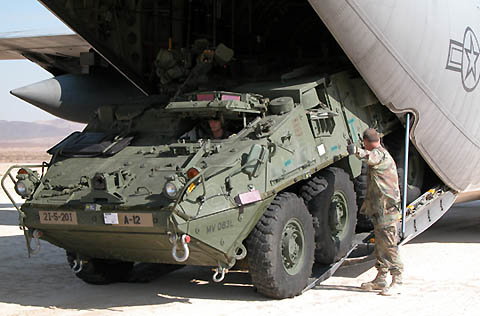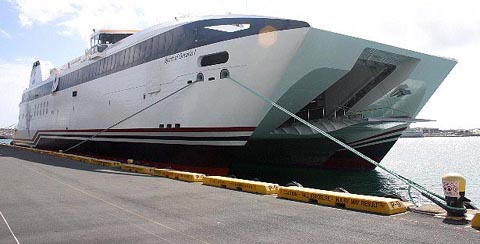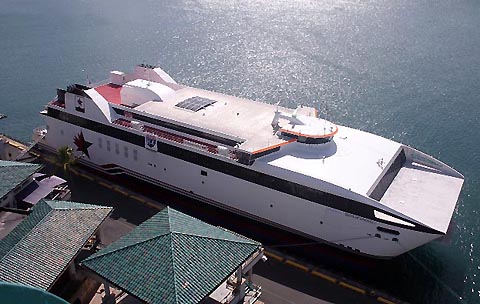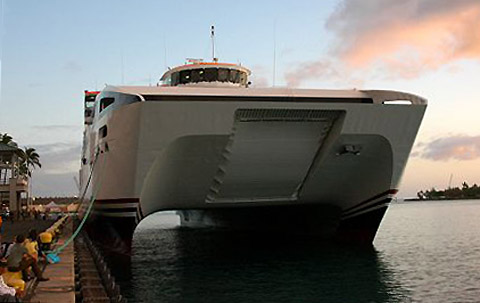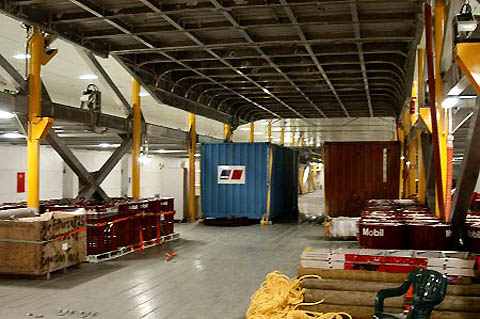|
by Valerie Monson on 18 June 200 in The Maui News
Whether she likes it or not, Gov. Linda Lingle is being dragged
into the controversy over Hawaii Superferry as the fallout over
congestion at Kahului Harbor continues.
Maui paddlers, farmers, small-business owners and others concerned
about the impact of Superferry on local cargo service and use
of the harbor will hold a "Freight First" rally from
4 to 5:30pm. Wednesday at Hoaloha Park on Kaahumanu Avenue. The
purpose of the demonstration is twofold: to ask Lingle to delay
ferry operations until impacts are resolved and to get the U.S.
Coast Guard to exempt canoe clubs from the security zone that
will increase around the pier.
"And if they don't give us the exemption, then move the Superferry,"
said paddler Karen Chun.
The demonstration will be just one wave in a surge of activity
that will take place during what might be described as "Harbor
Week" on Maui. No fewer than six meetings will be held in
four days beginning Monday night regarding the tight squeeze at
the docks and the impact of Superferry operations coupled with
the burgeoning business of interisland cargo shipper Young Brothers
Ltd. and the overall lack of room at the harbor.
Superferry and the state Department of Transportation will hold
three public meetings on their plans to transport as many as 866
passengers and 282 cars on a four-story vessel that's longer than
a football field. Young Brothers officials will hold three meetings
of their own to explain what steps they must take after being
ordered to give up a fourth of their space at Pier 2 to accommodate
Superferry, which is expected to launch in July of 2007.
For more than a year, Superferry has been accused of dodging the
general public, although company executives disagree. As a condition
on the release of a final $20 million needed for harbor improvements
for Superferry around the state, the lawmakers required company
and state transportation officials to hold a series of three community
meetings on each island where the vessel will dock. The intent
of the bill was to establish an ongoing dialogue with each island
community, not to have a flurry of meetings within hours of each
other and then never come back, said state Sen. Shan Tsutsui,
who represents Central Maui.
"We put in specific dates that they needed to hold the meetings
by so that Superferry would have a series of meetings where they
would provide information, respond to questions and continue to
update the community," said Tsutsui. "I'm certain DOT
and Superferry understands what the language is."
Barry Fukunaga, DOT deputy director for harbors, said he did not
expect these three sessions on Maui to be the only ones held.
Lawmakers said that meetings must be conducted on each island
affected by Superferry before the end of June, the end of September
and the end of March. Fukunaga said he couldn't be definite about
a September meeting, but he said there would be more in the future.
"For the initial series, we wanted to have sufficient venues
instead of meeting in just one place," said Fukunaga when
asked to comment after a meeting with Young Brothers and Molokai
residents in Kaunakakai earlier this week. "Ultimately, there
will be more progress" that will be discussed down the line,
he said.
Because Superferry will sharply cut into Young Brothers' cargo
space at Pier 2, the interisland shipper recently announced that
it would no longer have room to handle partial loads in or out
of Kahului Harbor, prompting an uproar from small-business owners
and farmers on Maui and Molokai alike. To address community concerns,
Young Brothers leaders have spent the past month trying to quell
the storm over a situation that they didn't create.
"The burden is on us right now," said Roy Catalani,
vice president of strategic planning and government affairs for
Young Brothers. "We've been meeting with freight forwarders,
consolidators, trade organizations, the Farm Bureau, the Maui
mayor's office, Molokai farmers and retailers, and having lots
of internal meetings to sketch out a plan of these complicated
changes."
The company has vowed to work with the community to find solutions
to the loss of delivering shipments that take up less than a full
container. Young Brothers acknowledged that it was planning to
discontinue the smaller loads around Hawaii in a few years, but
only recently realized the timetable at Kahului would have to
be speeded up to meet a Jan. 1 deadline to move out of Superferry's
portion of the pier and yard.
This week, Superferry and DOT officials will face questions from
members of the public. Among the issues expected to be discussed
is the state's agreement that Superferry should pay a $4 wharfage
fee per vehicle when Young Brothers must pay a total of $21 for
the same thing. Superferry will also pay the state just $20 per
commercial vehicle. Young Brothers pays as much as $300 for a
tour bus. All costs are passed on to consumers.
Young Brothers said the system needs to be fair. "We want
our customers to be treated as those of any other carrier,"
said Catalani.
Another issue likely to be raised is the makeup of the Superferry's
board of directors, which is almost completely controlled by partners
or consultants with the Mainland-based J.F. Lehman and Co.
Lehman, the former secretary of the Navy under President Ronald
Reagan, is Superferry's biggest private investor, sinking $71
million into the project. (The Maritime Administration has also
provided a $139.7 million Title XI federal loan guarantee.)
When Superferry applied for its water carrier license to the Public
Utilities Commission in November 2004, none of the three directors
listed were connected to Lehman. Now, five of eight directors
are tied to Lehman, who is chairman of the board. Another director
is David Cole, chief executive officer of Maui Land & Pineapple
Co., also a Superferry investor.
John Garibaldi, chief executive officer for Superferry, said it's
not unusual for the company's investors to have a seat at the
table.
"That's where a substantial amount of our equity is coming
from," he said.
It's also uncertain whether the concerns of Kahului Harbor Master
Steve Pfister will be addressed during discussions of the Superferry.
He told The Maui News last month that because of the lack of infrastructure
and permanent facilities, he thinks Superferry could be "struggling"
financially only a month or two after it starts.
Garibaldi called Pfister's comments "baseless claims"
even though the harbor master, a Navy veteran who has said he
wants Superferry to succeed, schedules all incoming vessels at
Kahului and must make everything fit.
"I'm not sure what information Mr. Pfister has," said
Garibaldi. "I don't know if he really understands our operation."
State support for the Superferry project has been questioned,
but Fukunaga said the governor has not expedited the approval
process for Superferry. He said the governor has long supported
the concept of an interisland ferry system, but that she has not
pressured him to favor Superferry.
"The governor recognizes that Superferry is a form of transportation
that does not exist," he said. "We're an island state,
and this will allow us not to depend so much on air travel.
"The challenge is how best to accommodate it."
At least twice in public meetings when DOT was under fire, Young
Brothers came to Fukunaga's defense and said he was one of the
best state administrators they had worked with in 15 years.
In April, Garibaldi told a joint legislative committee that Superferry
had delivered "35 percent" of its operating plans to
the state and that the entire document might not be ready until
the fourth quarter of the year. He said that would leave plenty
of time for review.
Fukunaga said that when Superferry was first proposed, all possible
berths at Kahului Harbor were explored.
"We actually examined Pier 1, Pier 4, Pier 3 and different
arrangements at Pier 2," he said. "You have to find
a balance. We thought by tying it to the end of Pier 2, it would
work. We don't want to impact the recreational site."
The state plans to purchase more land around the harbor and reconfigure
it for Young Brothers, but that additional space won't be available
for a few years.
Karen Chun said that's why Superferry should be delayed.
"They're putting the cart before the horse," she said.
One of the biggest selling points for Superferry has been the
price of its fares, which are expected to be lower than the average
plane tickets. Lowest one-way fares for the three-hour journey
from Maui to Oahu are $42, but that's only for travel on off-peak
days (Tuesday through Thursday) and if purchased in advance over
the Internet. Otherwise, one-way fares jump to $50 or $60. To
get into the more exclusive "club class," there's another
$15 charge.
A car or sport utility vehicle starts at $55 one-way, with higher
fares for peak days (Friday through Monday). A pickup or van would
cost $90 or $100 one-way.
But those figures were announced two years ago when fuel prices
were much lower. Superferry reportedly burns a lot of fuel per
hour. (Garibaldi said he didn't know the exact amount of consumption.)
So will prices be higher when Superferry launches next year? "Fuel
is an item that affects any transportation company, and it will
be formulated into the cost of a ticket," said Garibaldi.
Regarding the impact on Superferry's prices, Garibaldi said he
hadn't done the calculations yet. "There might be a small
amount added to (publicized fares)," he said.\
Garibaldi said Superferry continues to focus on passenger travel
and not cargo. Although the Web site encourages Neighbor Island
farmers to ship produce and cattle via the vessel, those vehicles
carrying products or livestock must be driven on and off the ferry
by someone who travels with them. Garibaldi said there are no
plans to allow vehicles or cargo to be loaded on one end and unloaded
by someone else at the other.
"We're just operating the ferry. We don't move cargo or freight,"
he said. "We're just offering people an alternative vehicle.
A lot of entrepreneurs are looking at this kind of business model.
Does it make sense to drive your produce, drive your products
from one island to another by using the ferry?"
Young Brothers' decision to eliminate the shipment of partial
loads out of Kahului Harbor prompted Maui County Council Member
Danny Mateo to appeal to Lingle, especially on behalf of Molokai
residents.
Lingle replied that Young Brothers had informed her staff that
"smaller loads would continue along with the current twice-weekly
barge service that is presently provided" to and from Molokai.
The governor noted that Young Brothers would have to "make
some adjustments" in order to continue the service, but she
did not mention that Molokai residents would have to pay for a
consolidator to load or unload at Kahului Harbor, which will raise
prices for everyone.
Mateo was not satisfied with Lingle's answer.
"Her response didn't tell me anything but 'That's the way
it is, Danny,' " said Mateo. "It's only a partial answer.
The irony of it all is that Young Brothers does not control the
harbors - the state does. The state's lack of planning has failed
us. We're in limbo right now."
Despite all the concerns, it seems doubtful that the state will
put the brakes on Superferry. As part of an agreement signed by
state officials, taxpayers would pay Superferry $18,000 a day
if infrastructure isn't in place by the company's launch date.
|
